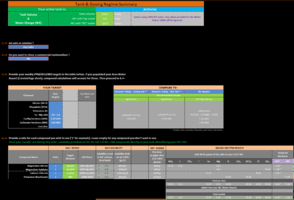I am planning to start preparing a DYI fertilizer, likely a clone of the "APFUK EI start kit" or "EI mid" since I am using a significant amount of Tropica aquasoil. I can also try the "EI full" if that is a good option for a tank with (new) subtsrate and aquasoil. This is a ~250l tank with CO2 injection. Sadly, I will be forced to start using RO water in a few weeks since a water softener (using sodium chloride) was installed in our condominium. This means I will also need to re-mineralize the RO water after the weekly water changes.
The goal is to prepare a liquid macro "all in one" solution since I have a dosing pump. For now, I will continue using a commercial micro liquid fertilizer with chelated iron. In terms of macro salts, I can get hold of the following:
I am using the ICF calculator to get the correct dosages. My questions are the following:
Regarding the RO re-mineralizer. I was advised to use <this one> and to raise GH to 6° and KH to 3° (conductance of ~300µS). Could anyone give me some tips on how to produce a DYI re-mineralizer with a similar GH:KH ratio and a suitable Mg:Ca ratio?
Many thanks for any suggestions!
The goal is to prepare a liquid macro "all in one" solution since I have a dosing pump. For now, I will continue using a commercial micro liquid fertilizer with chelated iron. In terms of macro salts, I can get hold of the following:
- Potassium Phosphate (KH2PO4)
- Potassium Sulfate (K2SO4)
- Magnesium Nitrate Hexahydrate (MgN2O6-6H2O)
- Note: there is no way to get Potassium Nitrate around here.
I am using the ICF calculator to get the correct dosages. My questions are the following:
- Do I need to adjust the amount of Magnesium Nitrate since the calculator does not seem to have the Hexahydrate version (MgN2O6-6H2O)? Or the Hexahydrate has no significant impact on the numbers?
- I am planning to dose ~30 ml daily. So, 1 liter of the macro solution will last ~4 weeks. Should I add a stabilizer to the solution? If yes, what exactly will I need to add? I have seen a dozen different answers to this question...
Regarding the RO re-mineralizer. I was advised to use <this one> and to raise GH to 6° and KH to 3° (conductance of ~300µS). Could anyone give me some tips on how to produce a DYI re-mineralizer with a similar GH:KH ratio and a suitable Mg:Ca ratio?
- Which salts do I need for the re-mineralization? Or is it preferable to use a commercial re-mineralizer?
- Is there any chemical interaction I need to be aware of between the re-mineralizer salts and the macro salts?
Many thanks for any suggestions!



